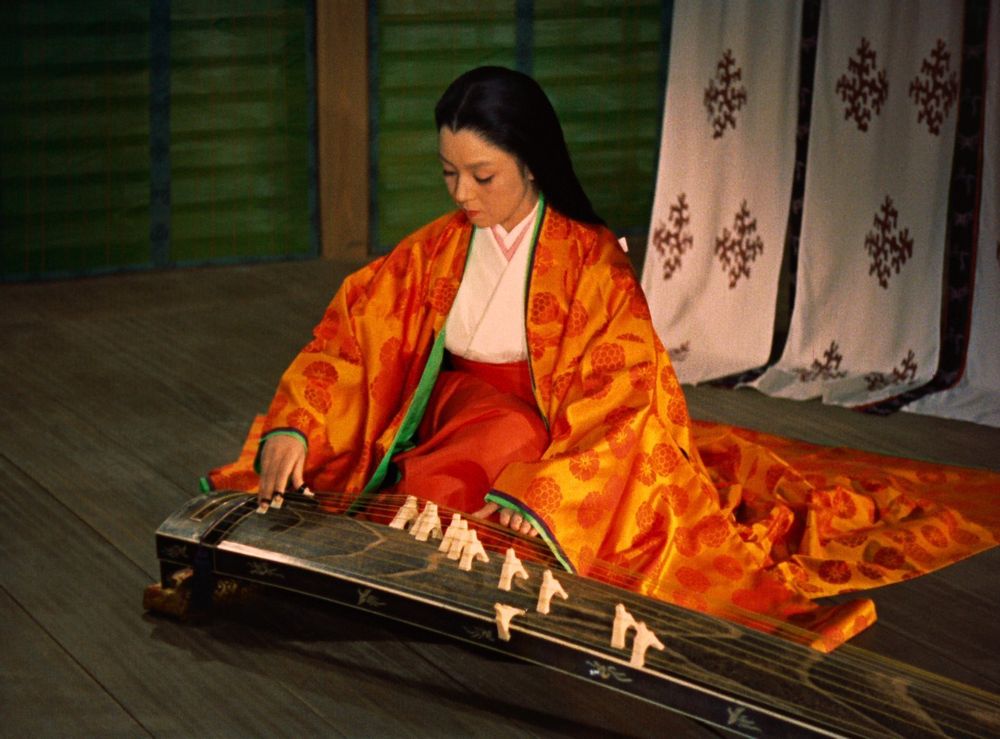
Gate of Hell (Jigokumon, 地獄門) is a 1953 Japanese film, starring Kazuo Hasegawa and Machiko Kyo, and directed by Teinosuke Kinugasa (A Page of Madness).
The film is set during the Heiji Rebellion of 1160. Morito (Hasegawa) is a samurai who remains loyal to the emperor during the uprising. When the rebel forces attack the royal palace, Lady Kesa (Kyō), a lady-in-waiting at the royal court, is designated to be a decoy for the Queen. Morito is charged with taking her away from the castle in order to lure the rebels away from the real Queen's escape.
Morito takes Kesa to his home, where he runs into his own brother, who has joined the rebellion. Morito refuses his brother's invitation to join the rebels and goes back to the palace, while Kesa escapes. The rebellion is put down. Morito's lord offers him a reward for his loyalty, and Morito asks for Kesa's hand in marriage. The lord is ready to give her to him, until a courtier tells them that Kesa is already married to Watanabe, another samurai. This does not dissuade Morito.
Gate of Hell won an honorary Academy Award for best foreign-language film.
Tropes:
- As You Know: A fair amount of clumsy expository dialogue in the early going."Sir Wataru must be very angry. Like us, he's from the Fujiwara clan."
- Body Double: Lady Kesa impersonates the queen in order to draw the rebels away from the real queen.
- Comforting Comforter: Kesa tucks her husband in right before her Heroic Sacrifice.
- Costume Porn / Gorgeous Period Dress: Besides the honorary Oscar this film won for best foreign-language film, it won a competitive Oscar for costume design. Lots of ornate 12th-century Japan costumes.
- Dead Guy on Display: Sir Shinzei, leader of the rebellion, gets his head put on top of the gate to the royal palace.
- Entitled to Have You: A variant. Morito was loyal, his lord granted him a boon, and he asked for Kesa. He does not care if she's already married.
- Fake Action Prologue: The movie starts off In Medias Res with the rebel assault on the castle and the panicked flight of the loyalists, with Kesu and Morito drawing the rebels away. Then that all ends, and the film becomes a story of love and obsession.
- Heroic Sacrifice: Morito finally tells Kesa that he's going to kill her husband and have her, and if she doesn't cooperate, he'll kill her and her aunt too. So Kesa coaxes her husband into sleeping in her room, whereupon she lies down to sleep in his. Morito thus winds up accidentally killing her instead.
- Important Haircut: A grief-stricken Watanabe refuses to kill Morito, saying it will do no good. Morito then slices off his queue (mandatory for a samurai) and says he will become a monk.
- Kick the Dog: Morito literally does this as he waits impatiently outside Kesa's house.
- Love Makes You Crazy / Love Makes You Evil: Morito comes completely unglued when Kesa rejects his advances and his lord refuses to force her to divorce her husband and marry him.
- Murder the Hypotenuse: Well, if the woman you like won't divorce her husband, what else are you supposed to do?
- Protagonist Journey to Villain: Morito starts out as a brave and noble samurai. His lust for Kesa turns him homicidal.
- Samurai: Lots of them!
- Stalker with a Crush: All in all, Morito would have been best advised to find a different girlfriend.
- Title Drop: The "gate of hell" is the gate to the palace where the heads of rebels get mounted.
